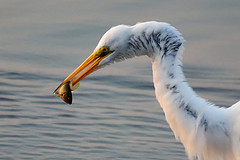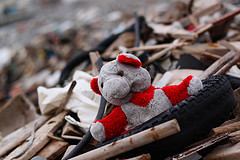Microscopic creatures, organisms and bacteria have been found living on tiny pieces of plastic in the ocean. Australians discard nearly 1.5 megatons of plastic each year, with only around 1 in 5 pieces recycled. As the old adage goes, eventually everything ends up in the ocean.
Julia Reisser, a PhD candidate from the University of Western Australia, has been studying oceans for years. She’s part of a team researching the ‘garbage islands’, the places where currents congregate to form an island of millions of tons plastic pieces less than 5mm large.
These pieces are called ‘microplastics’ and they’re formed from what we throw away – wrappers, cups, tooth floss and fishing line. Sunlight and heat will cause any plastic object to break down to tiny pieces.
However, Ms Reisser’s interest isn’t in what microplastics are made of, or even where they come from: she studies what kinds of organisms live on them.
“We were quite surprised to find a whole ecosystem living the microplastics,” she says, “although it’s a perfect environment for them.”
Plastic floats in water, meaning the organisms have an underwater surface that’s still getting sunlight.
“We find a very high diversity of organisms – each piece you look at, you find something different there.”
“We’ve found 90 new organisms that weren’t known to be associated with plastics before. The vast majority are bacteria and microscopic plants such as diatoms, and also lots of tiny little creatures like invertebrates.”
In the food chain
The organisms can then be eaten by others, or by tiny fish, and form the base of the food chain in their ecosystem. This would be great if it weren’t for the fact that plastic attracts a lot of toxic material in the ocean.
“The plastic surface acts like a sponge to oily pollutants. The load of toxins on the plastic’s surface is thousands of times higher than in the surrounding water,” says Ms Reisser.
This means that the organisms absorb the pollutants, and there are thousands of them in the ocean. Petroleum, insecticide, fertiliser and a myriad of other toxic substances are all taken in by members of the microplastic community. These toxins are passed up the food chain, fish by fish.
This poses an even bigger problem when considering who’s at the top of the food chain. A recent study in Singapore showed that toxins commonly found on ocean plastics were showing up in the fish market. The effects of ingesting these chemicals in humans is still unknown – whilst we know we’re eating it, scientists don’t yet know what it’s doing to us.
In their ecosystems
Before humans started dumping large amounts of plastic in the ocean, there were clean, clear waters allowing the free passage of sunlight and animals. We’re slowly discovering that the popular saying touted by businesses “the solution to pollution is dilution” isn’t an effective fix.
“We have introduced a new type of habitat to certain areas,” says Ms Reisser.
“We have organisms that use these plastics like a boat… they use the plastic to travel around on the currents. Then you have the problems posed by invasive species.”
Specifically where currents meet, where garbage patches are formed, whole new and unnatural habitats are being created – and it’s extremely hazardous for the existing ecosystem.
“If you travelled to these areas, you’d see millions of pieces of floating garbage… and there’s organisms ingesting the plastics, there’s organisms getting entangled in them,” says Ms Reisser.
Declining populations of seals, sea turtles and birds are among the many deaths attributed to plastic in the ocean. There hasn’t been enough research on the subject to understand the long term effects on many species, but many scientists believe that plastic debris will cause hundreds of extinctions before a solution is found.
Among them include animals like the Hawaiian Monk Seal, whose extinction is directly attributed to man made debris.
In the future
But there might be a tiny piece of good news in all this – research coming out now indicates that some of these organisms are actually biodegrading the plastics they live on.
“Among this plastic community are organisms that are breaking down the plastics. If we could harness these organisms, perhaps we could use them on land to break them down,” says Ms Reisser.
This could be an effective solution for the 300 million tons of plastic that are produced every year. Only 10 percent of this is recycled, with the rest ending up in landfill and in the ocean.
Our “plastic footprint” is only becoming more important, and may become equally as central as the carbon footprint in 21st century environmentalism.
Ms Reisser believes there’s even a possibility to turn plastic into other useful substances.
“Maybe we can use these bacteria for what we call bio-remediation. Maybe in the future we could have a compost system where you put your plastic waste in with these microorganisms, and they biodegrade your plastics or maybe transform it into a bio-diesel or bio-fuel.”
Currently there are studies investigating the creation of bio-fuel with organic waste such as dried cornhusks, but none with plastic waste.
Unfortunately, implementing strategies like these is years away. For now, we should be conserving the amount of plastic rubbish we produce.
“Some of the plastic items we consume, we use for less than two seconds. We can try to decrease the plastic waste we produce on a daily basis and try to be mindful,” says Ms Reisser.
Much like the challenges on this South Korean reality TV show.
This article first appeared on the City Journal here





